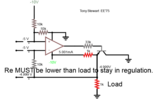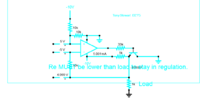Hi,
I'm learning how to use the UA741CP together with a 2N3392 to get a -5V voltage source.
For some reason, when I breadboard the components, I get 0.60V instead of the expected -5V.
I have created a Falstad circuit simulation and it does work, but my breadboard version does not.
I have checked the resistor values, and pin assignments many times and they seem ok. I tried swapping out the 741 and 2N3392.
Any ideas on what I could be doing wrong?
Here is the simulation:
Thank you!
I'm learning how to use the UA741CP together with a 2N3392 to get a -5V voltage source.
For some reason, when I breadboard the components, I get 0.60V instead of the expected -5V.
I have created a Falstad circuit simulation and it does work, but my breadboard version does not.
I have checked the resistor values, and pin assignments many times and they seem ok. I tried swapping out the 741 and 2N3392.
Any ideas on what I could be doing wrong?
Here is the simulation:
Thank you!



